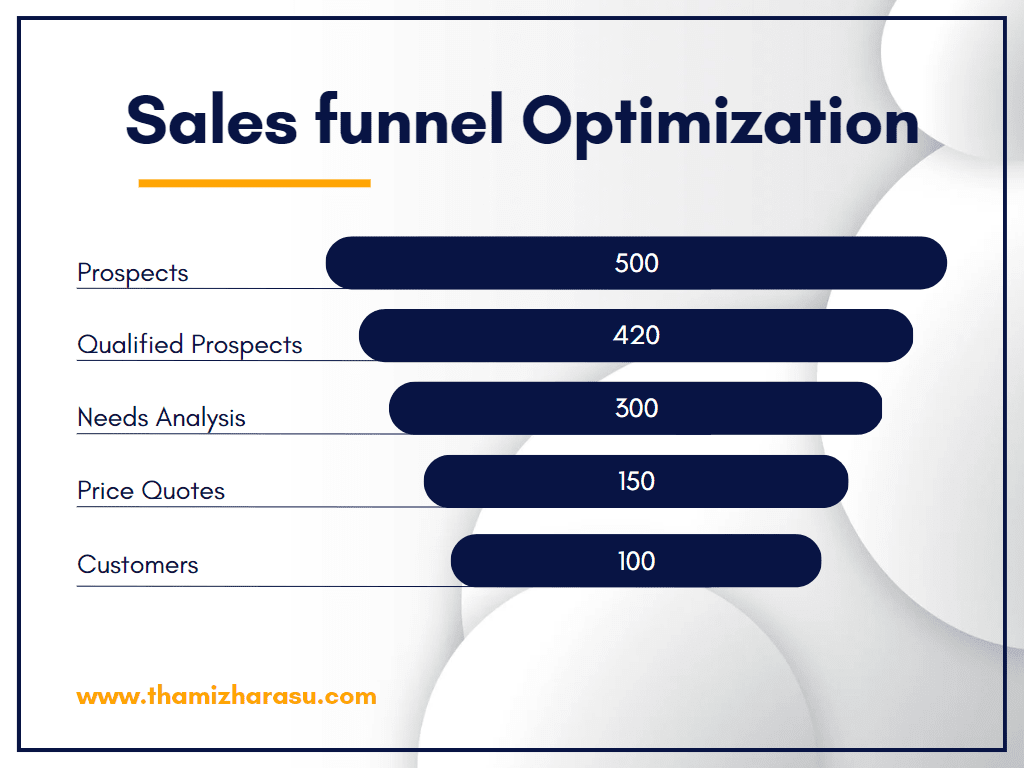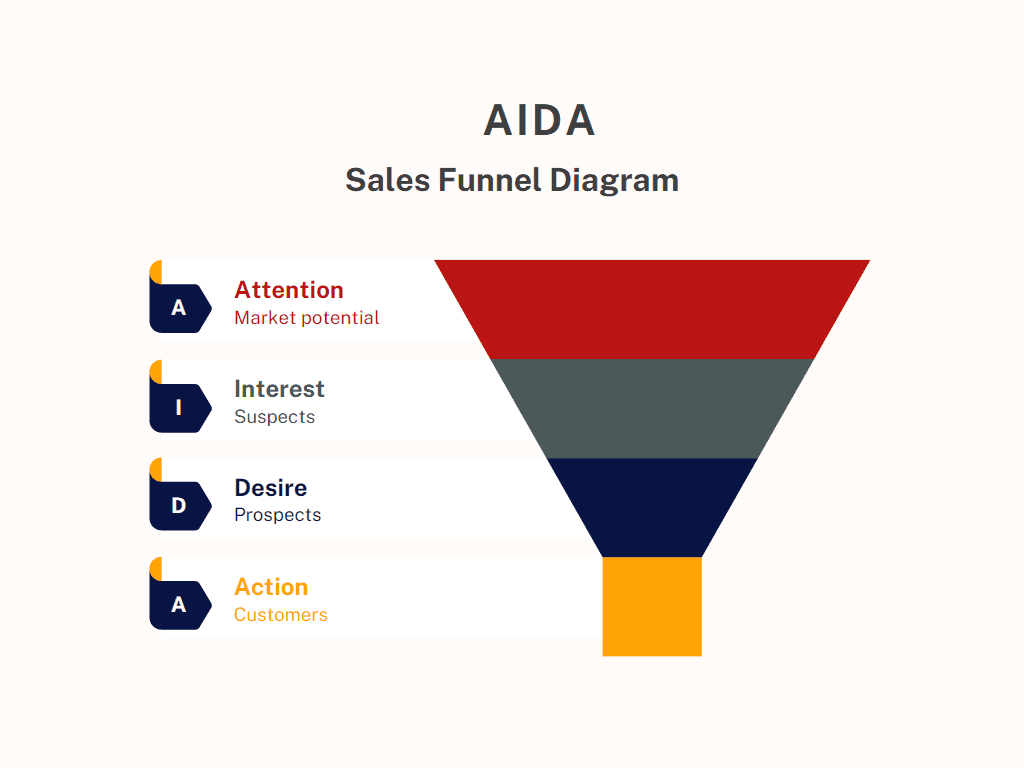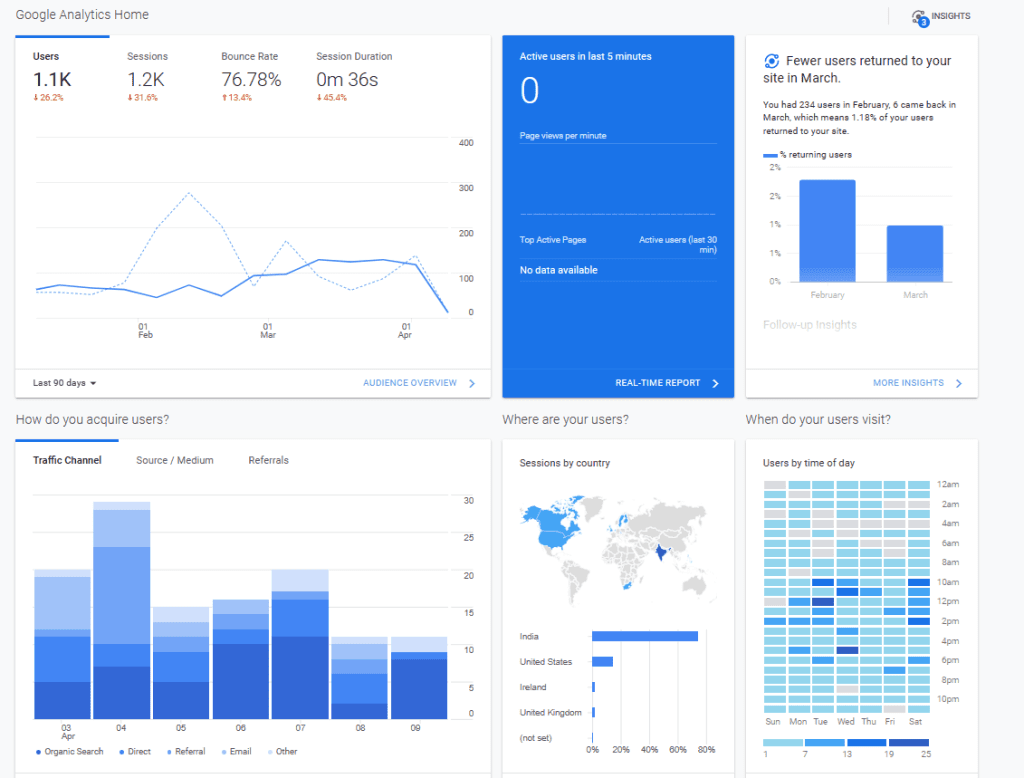- 11/04/2023
- Posted by: Thamizharasu Gopalsamy
- Category: Marketing

In this ultimate guide to sales funnel optimization, we’ll show you how to convert more leads into customers, increase revenue per customer, and ultimately boost your bottom line. From identifying bottlenecks in the funnel to implementing targeted campaigns for each stage of the buyer journey, we’ve got everything you need to turn that lackluster conversion rate into a revenue-generating powerhouse. Buckle up – it’s time for a deep dive into sales funnel success!
Understanding the Sales Funnel Stages
Sales Funnel Optimization is the process that marketing and sales teams use to move prospects through the buyer’s journey, from awareness to purchase. The goal of each stage is to nurture prospects and move them closer to becoming customers.
Awareness: The first stage of the sales funnel is awareness. In this stage, prospects are just becoming aware of the problem they have that your product or service can solve. They’re beginning their research and are starting to compare options.
Interest: In the interest stage, prospects have a better understanding of their problem and are actively looking for solutions. They know what they need and are now considering various options, including your product or service.
Consideration: In the consideration stage, prospects are narrowing down their options and comparing different products or services, including yours. They’re looking at features, prices, and other factors to decide which option is best for them.
Conversion: The conversion stage is when a prospect becomes a customer. At this point, they’ve decided to purchase your product or service and are taking action to do so.
Retention: The retention stage is when a customer continues to use your product or service after the initial purchase. It’s important to keep customers engaged and satisfied so they don’t churn (cancel their subscription or stop using your product).

Advocacy: Where satisfied customers become brand advocates by actively promoting and recommending your product or service to others. At this stage, customers have already experienced the value of your offerings and developed a strong relationship with your brand. They are now more likely to share their positive experiences with friends, family, or colleagues, and even on social media platforms.
Advocacy is important for several reasons:
Word-of-mouth marketing: Advocates provide genuine, organic word-of-mouth marketing, which is often more trustworthy and persuasive than traditional advertising.
Cost-effectiveness: Acquiring new customers through referrals from brand advocates is usually more cost-effective than spending on advertising or other marketing efforts.
Social proof: Positive testimonials, reviews, and endorsements from advocates can help build credibility and trust among potential customers, making them more likely to choose your brand.
Customer loyalty: Advocates are typically loyal customers who continue to support your brand and make repeat purchases, increasing their lifetime value.
To encourage and leverage customer advocacy, businesses can implement the following strategies:
Provide excellent customer service: Exceeding customer expectations and addressing their needs or concerns promptly can turn them into brand advocates.
Create a referral program: Offer incentives or rewards to customers who refer new clients, encouraging them to actively promote your brand.
Engage with customers on social media: Responding to customer comments, sharing their posts, and acknowledging their feedback can strengthen their connection to your brand and motivate them to share their positive experiences.
Collect and share testimonials and case studies: Showcase the success stories of your customers to demonstrate the value of your product or service, inspiring others to become advocates as well.
By fostering customer advocacy, businesses can not only improve their overall reputation but also drive new leads and increase revenue.
Strategies for Optimizing Each Stage of the Sales Funnel:
Generating targeted traffic:
To generate targeted traffic, you need to understand your audience and what they’re looking for. Once you have a good understanding of your target market, you can start to implement some marketing strategies to reach them.
SEO: Search engine optimization is a process of optimizing your website so that it ranks higher in search engine results pages (SERPs). By optimizing your site for certain keywords, you can attract more visitors who are searching for those terms.
Paid advertising: Paid advertising is a great way to reach a larger audience with your message. You can use paid ads on search engines, social media platforms, and other websites.
Social media: Social media is a powerful tool for connecting with potential customers. You can use social media to build relationships, share content, and drive traffic back to your website.
Creating compelling content:
Creating compelling content is essential at every stage of the sales funnel if you want to maximize your ROI. By addressing your target audience’s needs and providing valuable information, you’ll be more likely to convert leads into customers – and customers into lifelong fans!
Effective call-to-action:
The success of any call-to-action depends on its ability to persuade users to take the desired action. Creating a compelling call-to-action is therefore essential to optimize each stage of the sales funnel.
1. Use persuasive language: The language you use in your call-to-action should be persuasive and encourage users to take action. For example, instead of using the phrase ‘sign up for our newsletter,’ try something more persuasive like ‘get the latest news and exclusive discounts by signing up for our newsletter.’
2. Make it specific: Be clear about what you want users to do. Vague calls to action are less likely to be successful than those that are specific. For example, a CTA that simply says ‘click here’ is not as effective as one that says ‘click here to sign up for our newsletter.’
3. Use strong visuals: Strong visuals can help grab attention and make your CTA more effective. Use images, colors, or other visuals to make your CTA stand out.
4. Offer something valuable: Users are more likely to take action if they feel they will get something valuable in return. This could be a discount, exclusive content, or early access to a new product or service.
By following these tips, you can create CTAs that are more likely to encourage users to take action.
Implementing lead nurturing campaigns:
The lead nurturing process is designed to turn leads into customers. The goal is to build relationships with leads, provide them with valuable information, and gradually move them through the sales funnel.
Email marketing can be used to nurture leads by sending educational content, special offers, or invitations to webinars or other events. Retargeting ads can also be used to keep leads engaged by showing them relevant ads as they browse the web. Other tools that can be used in lead nurturing campaigns include chatbots and CRM software.
Enhancing user experience:
The first stage of the sales funnel is the most important because it’s when you make your first impression on potential customers. To optimize this stage, focus on enhancing your website’s usability and mobile responsiveness. Make sure your pages load quickly and that users can easily find what they’re looking for.
The second stage of the sales funnel is when you turn those potential customers into leads. To do this, you need to have a solid strategy for capturing and managing leads. Once you have a lead, make sure you follow up with them in a timely manner and keep them updated on your product or service.
The third stage of the sales funnel is when you close the deal and convert those leads into customers. This is where your pricing comes into play. Make sure you have a competitive pricing strategy that meets the needs of your customer while also maximizing your profits.
By optimizing each stage of the sales funnel, you can ensure that you’re making the most of your marketing efforts and generating the highest ROI possible.
Leveraging social proof and testimonials:
One way to optimize the sales funnel is to leverage social proof and testimonials. Customer reviews, case studies, and endorsements can all help build trust and credibility with potential customers. By featuring these elements prominently on your website and in your marketing materials, you can make it more likely that prospects will move further down the funnel toward becoming a customer.
Key Metrics to Measure Sales Funnel Performance:
Conversion rates:
Conversion rates are one of the most important metrics to measure sales funnel performance. They can help you identify areas of your funnel that need improvement and show you where your optimization efforts are most effective.
There are a few different ways to track conversion rates. One is to track the number of leads that convert into customers at each stage of the funnel. This can help you identify which stages of the funnel are most effective and where you need to focus your optimization efforts.
Another way to track conversion rates is to track the overall conversion rate from start to finish. This can help you pinpoint problem areas in your funnel and see where you need to make changes.
Once you know how to track conversion rates, there are a few things you can do to improve them. One is to focus on quality over quantity. Make sure that your leads are high-quality and relevant to your business before trying to convert them into customers.
You should also focus on making it easy for leads to convert into customers. Make sure that your website is easy to navigate and that your forms are simple and straightforward. The easier it is for leads to convert, the higher your conversion rate will be.
Cost per acquisition (CPA):
There are a number of key metrics that can be used to measure the performance of a sales funnel, but one of the most important is a cost per acquisition (CPA). CPA is a measure of how much it costs to acquire a new customer and is a key factor in evaluating the effectiveness of marketing campaigns and setting realistic budgets.
There are a number of factors that go into calculating CPA, but the basic formula is fairly straightforward:
CPA = Cost of Campaign / Number of Acquisitions
For example, if you spend $1000 on a marketing campaign and it results in 10 new customers, your CPA would be $100.
CPAs can vary widely depending on the type of business and the nature of the products or services being sold. For some businesses, a CPA of $100 might be considered very good, while for others it might be considered too high. As such, it’s important to benchmark your CPA against other businesses in your industry to get an idea of what is considered normal or acceptable.
Additionally, CPAs can change over time as your business grows and matures. As such, it’s important to regularly monitor your CPA and adjust your marketing budgets accordingly. By doing so, you can ensure that you’re getting the most bang for your buck when it comes to acquiring new customers.
Customer lifetime value (CLV):
CLV is a key metric in understanding the long-term value of a customer and making informed decisions about customer acquisition and retention. By calculating CLV, businesses can determine how much money they can realistically expect to earn from a single customer over the course of their relationship. This information can then be used to make informed decisions about where to allocate marketing resources and how to price products and services. Additionally, CLV can be a useful tool for evaluating the success of customer retention efforts. By tracking changes in CLV over time, businesses can gauge the effectiveness of their retention strategies and make necessary adjustments.
Retention rate:
It’s important to monitor your sales funnel’s retention rate to identify any potential issues that could be causing customers to lose interest. By understanding what causes customers to churn, you can implement strategies to improve customer loyalty and keep them engaged with your brand.
Churn Rate:
This metric measures the percentage of customers who stop using your product or service within a certain period of time. A high churn rate can indicate that there are issues with your product or service that need to be addressed.
Net Promoter Score (NPS):
This metric measures customer satisfaction and loyalty. NPS can help you identify which customers are likely to recommend your product or service to others.
Customer Retention Rate:
This metric measures the percentage of customers who continue using your product or service over time. A high retention rate indicates that customers are satisfied with your product or service and are unlikely to churn.
Monitoring these key metrics will give you insights into how well your sales funnel is performing and where you need to make improvements. By improving retention rates, you can maximize your ROI and ensure that your
Leveraging Marketing Automation Tools for Funnel Optimization:
Email marketing:
Email marketing is one of the most effective ways to nurture leads and drive conversions. By using an email marketing platform, businesses can automate and personalize their lead-nurturing campaigns to improve ROI. Email marketing platforms offer a number of benefits, including the ability to:
– Automate email campaigns: Email marketing platforms make it easy to automate your lead-nurturing campaigns. You can set up trigger-based emails that are sent automatically when a lead takes a certain action, such as subscribing to your newsletter or downloading a white paper.
– Personalize emails: Email marketing platforms allow you to personalize your emails to each individual lead. You can use data from your CRM system to segment your leads and send them highly targeted, personalized emails that are more likely to convert.
– track results: Email marketing platforms provide detailed reports on the performance of your email campaigns. This data can help you optimize your campaigns for better results.
CRM systems:
In order to optimize your sales funnel, it is important to have a clear understanding of your customer interactions. This is where CRM software comes in. CRM (customer relationship management) software tracks and manages customer interactions, providing valuable insights that can be used to improve your sales funnel.
There are many different CRM software options available, so it is important to choose one that will fit the needs of your business. Once you have selected a CRM system, you will need to set up a process for tracking and managing customer interactions. This will involve creating a database of customers and their contact information, as well as tracking the interactions that each customer has with your business.
The data that you collect in your CRM system can be used to improve the effectiveness of your sales funnel. For example, if you notice that a particular type of customer is not responding well to your sales pitch, you can adjust your approach accordingly. Additionally, if you find that certain steps in your sales process are causing customers to drop off, you can make changes to eliminate those roadblocks.
By tracking and managing customer interactions using a CRM system, you will gain valuable insights that can be used to optimize your sales funnel and maximize your ROI.
Landing page builders:
As the first step in any funnel, your landing page is key to conversion success. A well-designed, optimized landing page can make all the difference in whether a user takes the next step in your funnel or not. Landing page builders are a great way to create high-converting landing pages quickly and easily. With a drag-and-drop interface and pre-built templates, you can create professional-looking landing pages without any design experience.
Most landing page builders also include features like A/B testing and email capture forms to help further optimize your pages. By testing different versions of your landing page, you can see which one performs better and make changes accordingly. Email capture forms help you grow your list of leads by collecting contact information from users who visit your site.
By leveraging the power of marketing automation tools, you can create landing pages that are optimized for conversion success. With just a few clicks, you can have a professionally designed landing page that is ready to start driving results for your business.
Analytics and tracking tools:
Sales funnel optimization is all about improving the conversion rate at each stage of the funnel. And one of the most important aspects of sales funnel optimization is tracking and measuring performance.
Analytics tools are essential for tracking and measuring sales funnel performance. They help you identify areas for improvement and track progress over time.
There are a number of different analytics tools available, but some of the most popular include Google Analytics, Mixpanel, and KISSmetrics. Each of these tools has its own strengths and weaknesses, so it’s important to choose the right tool for your needs.

No matter which analytics tool you use, there are a few key metrics you should always track:
-Number of visitors: This metric tells you how many people are entering your sales funnel. If this number is low, it could be an indication that your marketing efforts aren’t reaching enough people.
-Conversion rate: This metric tells you what percentage of visitors are converting into leads or customers. If this number is low, it could be an indication that there’s something wrong with your sales funnel (e.g., a leak).
– Average order value: This metric tells you how much money each customer is spending on average. If this number is low, it could be an indication that your prices are too low or that your products/services aren’t perceived as valuable by your customers.
Conclusion
With this ultimate guide to sales funnel optimization, you should now have all the tools and knowledge needed to maximize your ROI. You’ve learned about segmenting and personalizing your audience, creating an effective lead magnet, setting up a website with landing pages optimized for conversions, optimizing each stage of the funnel through A/B testing, tracking results to measure success, and much more. Start putting it into practice today and soon you will be seeing positive results from your efforts in no time!
Leave a Reply
You must be logged in to post a comment.
